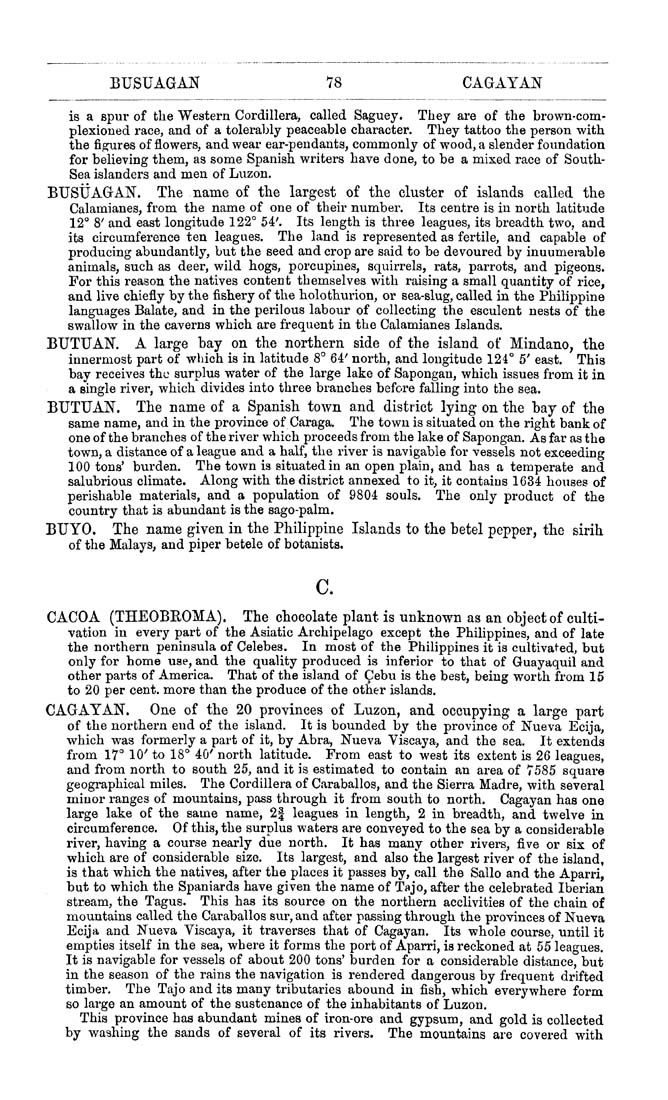BUSUAGAN 78 CAGAYAN
is a spur of the Western Cordillera, called Saguey. They are of the brown-com¬
plexioned race, and of a tolerably peaceable character. They tattoo the person with
the figures of flowers, and wear ear-pendants, commonly of wood, a slender foundation
for believing them, as some Spanish writers have done, to be a mixed race of South-
Sea islanders and men of Luzon.
BUSiJAGAN. The name of the largest of the cluster of islands called the
Calamianes, from the name of one of their number. Its centre is in north latitude
12° 8' and east longitude 122° 54'. Its length is three leagues, its breadth two, and
its circumference ten leagues. The land is represented as fertile, and capable of
producing abundantly, but the seed and crop are said to be devoured by innumerable
animals, such as deer, wild hogs, porcupines, squirrels, rats, parrots, and pigeons.
For this reason the natives content themselves with raising a small quantity of rice,
and live chiefly by the fishery of the holothurion, or sea-slug, called in the Philippine
languages Balate, and in the perilous labour of collecting the esculent nests of the
swallow in the caverns which are frequent in the Calamianes Islands.
BUTUAN. A large bay on the northern side of the island of Mindano, the
innermost part of which is in latitude 8° 64' north, and longitude 124° 5' east. This
bay receives the surplus water of the large lake of Sapongan, which issues from it in
a single river, which divides into three branches before falling into the sea.
BUTUAN. The name of a Spanish town and district lying on the bay of the
same name, and in the province of Caraga. The town is situated on the right bank of
one of the branches of the river which proceeds from the lake of Sapongan. As far as the
town, a distance of a league and a half, the river is navigable for vessels not exceeding
100 tons' burden. The town is situated in an open plain, and has a temperate and
salubrious climate. Along with the district annexed to it, it contains 1634 houses of
perishable materials, and a population of 9804 souls. The only product of the
country that is abundant is the sago-palm.
BUYO. The name given in the Philippine Islands to the betel pepper, the sirih
of the Malays, and piper betele of botanists.
c.
CACOA (THEOBROMA). The chocolate plant is unknown as an object of culti¬
vation in every part of the Asiatic Archipelago except the Philippines, and of late
the northern peninsula of Celebes. In most of the Philippines it is cultivated, but
only for home use, and the quality produced is inferior to that of Guayaquil and
other parts of America. That of the island of Qehu is the best, being worth from 15
to 20 per cent, more than the produce of the other islands.
CAGAYAN. One of the 20 provinces of Luzon, and occupying a large part
of the northern end of the island. It is bounded by the province of Nueva Ecija,
which was formerly a part of it, by Abra, Nueva Viscaya, and the sea. It extends
from 17° 10' to 18° 40' north latitude. From east to west its extent is 26 leagues,
and from north to south 25, and it is estimated to contain an area of 7585 square
geographical miles. The Cordillera of Caraballos, and the Sierra Madre, with several
minor ranges of mountains, pass through it from south to north. Cagayan has one
large lake of the same name, 2| leagues in length, 2 in breadth, and twelve in
circumference. Of this, the surplus waters are conveyed to the sea by a considerable
river, having a course nearly due north. It has many other rivers, five or six of
which are of considerable size. Its largest, and also the largest river of the island,
is that which the natives, after the places it passes by, call the Sallo and the Aparri,
but to which the Spaniards have given the name of Tajo, after the celebrated Iberian
stream, the Tagus. This has its source on the northern acclivities of the chain of
mountains called the Caraballos sur, and after passing through the provinces of Nueva
Ecija and Nueva Viscaya, it traverses that of Cagayan. Its whole course, until it
empties itself in the sea, where it forms the port of Aparri, is reckoned at 55 leagues.
It is navigable for vessels of about 200 tons' burden for a considerable distance, but
in the season of the rains the navigation is rendered dangerous by frequent drifted
timber. The Tajo and its many tributaries abound in fish, which everywhere form
so large an amount of the sustenance of the inhabitants of Luzon.
This province has abundant mines of iron-ore and gypsum, and gold is collected
by washing the sands of several of its rivers. The mountains are covered with
|








